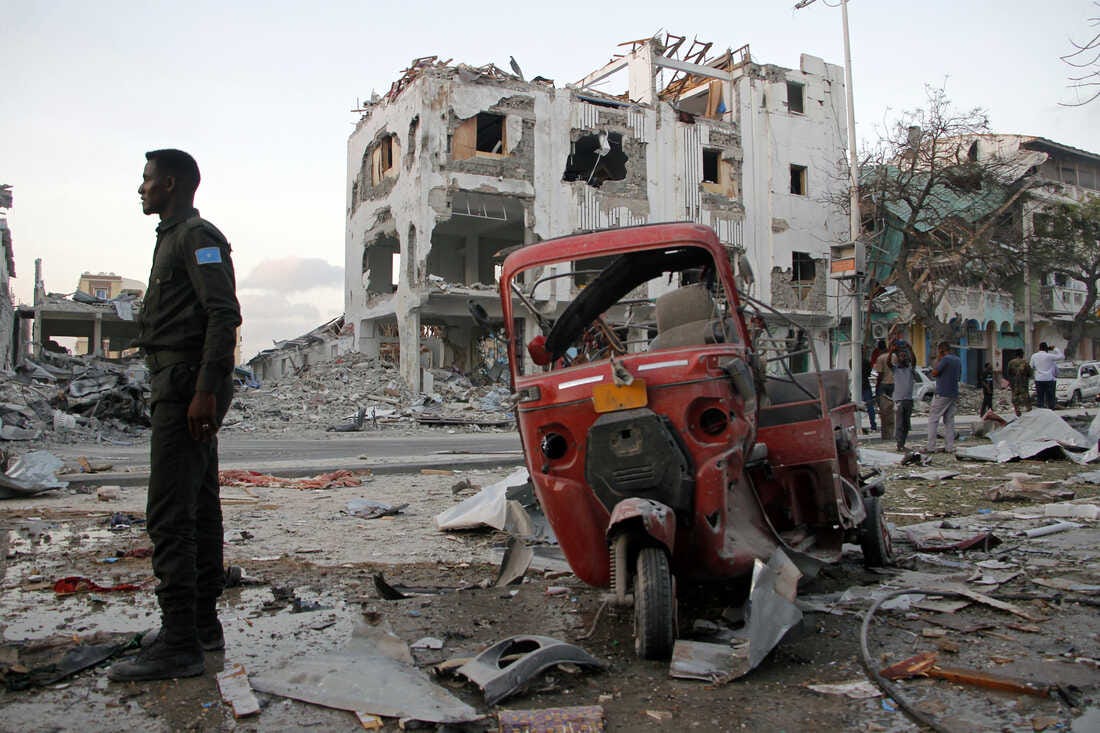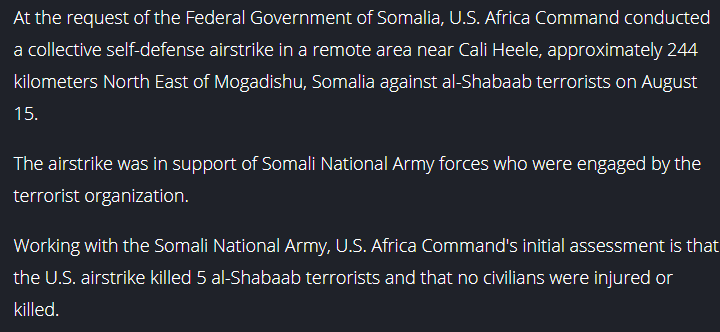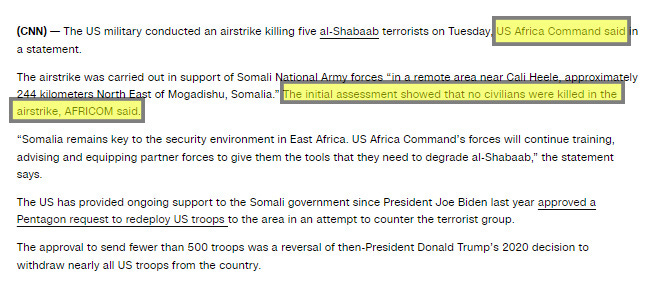The US Continues to Kill in Somalia
US Africa Command’s sporadic announcements indicate that its bombing terrorists. The media is taking its word.

Last month, Maalim Ayman, a senior leader of the Al-Shabaab militant group, was killed by a US drone.
It’s a name few people would recognize, despite the fact that the US government had been offering a reward of up to $10 million for his capture prior to the assassination.
US officials say that Ayman was responsible for planning the January 2020 attack at Manda Bay Airfield in Kenya that killed two American contractors as well as a US Army specialist. Two other US service members as well as a third US contractor were also injured during the incident. Furthermore, Ayman is also believed to have planned the 2015 attack on Kenya’s Garissa University which killed 148 people. The State Department designated Ayman as a Specially Designated Global Terrorist (SDGT) in November 2020.
Still, this wasn’t the killing of Osama bin Laden, and it wasn’t the middle-of-the-night raid that nabbed Khalid Sheikh Mohammed. Although the development was covered by every major outlet, it left the news cycle shortly thereafter and the country moved on. Because such a small number of Americans knew anything about Ayman, or care about his killing, what’s also lost on most of the country is how many innocent civilians are also routinely murdered in operations like the December 17th strike that took his life.
As is the case with all US wars and foreign operations, the Pentagon’s yearslong campaign in Somalia is shrouded in secrecy. The corporate press rarely provides its audience with the necessary background to understand how a group like Al-Shabaab could rise to power, why the US considers involvement in Somali affairs important, and just how many innocent civilians pay the price for assassinations like the one that killed Ayman.
As this page covered earlier this fall, the US military’s intervention in the Horn of Africa stretches back decades. No different from any other US-led interference, Washington’s objectives in Somalia have always centered squarely on its geopolitical goals. Occasional headlines about violence in Somalia reinforce the government’s insistence that we must continue the so-called “War on Terror,” but what’s rarely acknowledged is that the US is pretending to try to fix a mess it helped created in the first place.
The US government spent years backing the regime of Somali leader Mohammed Siad Barre despite his documented detention, torture, and killing of thousands of dissidents. Because Somalia’s next-door neighbor and geopolitical rival, Ethiopia, was aligned with Moscow, the US chose to turn a blind eye to Barre’s egregious human rights abuses because of its desire to use him as a counterweight to the Soviet Union’s influence in the region.
That Barre’s government had been responsible for the deaths of as many as 60,000 people between 1988 and 1989 alone wasn’t enough to deter the US from propping up his regime. A mutually beneficial relationship between the two nations saw Somalia receive some $100 million in annual military and economic aid from Washington in the 80s, while the Americans were granted access to the port of Berbera on the Gulf of Aden.
After Barre was overthrown in 1991, Somalia experienced a devastating civil war. In the wake of the government’s collapse, it was the Islamic Courts Union (ICU) that restored basic public services for the population.
In 2006, the US backed Ethiopia’s invasion of Somalia, as Ethiopia overthrew the ICU, and occupied the country until 2009. Just as US-led intervention did in Iraq, this latest conflict would also spur a domestic insurgency; in this instance, it was led by Al-Shabaab, a militia group whose intention was to protect the ICU from the foreign invaders. As the Ethiopian occupation continued, Al-Shabaab grew more and more violent. By 2007, the group gained control of a substantial portion of the country, resulting in further intervention by the UN and the African Union. US forces began training Somali and African Union soldiers and launched airstrikes targeting the leadership of Al-Shabaab.
America is using a mess it helped create as a pretext to intervene in a part of the world it deems strategically valuable.
Today, Al-Shabaab routinely launches attacks against the US-backed Somali government as well as targets in neighboring countries that sent in troops to intervene in Somalia’s affairs. In essence, the US is now intervening to resolve a problem that wouldn’t exist without its decades of involvement in Somalia in the first place. More importantly, this is intervention that serves the US government’s interests, not Somalia’s.
At the heart of America’s decades-long concentration on Somalia is geography. On the country’s northern coast sits the Gulf of Aden, which leads to the Bab el-Mandeb Strait, one of the most crucial waterways on earth. Through this extremely narrow chokepoint moves all of the maritime traffic traveling between the Mediterranean Sea and the Indian Ocean. If use of this passageway were to be discontinued, vessels transporting goods and oil between US/European and Asian markets would be required to travel around the African continent.
This is the type of context that is almost never provided to Western audiences. As a result, the relative apathy most Americans have for this region of the world is what allows the US government to continue its operations there with near impunity.
In between the public pats on the back the US government gives itself for killing terrorists like Maalim Ayman are the far less publicized airstrikes that murder the innocent civilians the US claims its working to protect.
Most of the time, mainstream news outlets simply parrot US Africa Command’s (AFRICOM) unverified claims about killing “terrorists” without demanding any evidence for the assertions that are being made.
Consider this formulaic AFRICOM press release from last summer, which contains the same language that can be found in every other recent communique about the US military’s operations in Somalia. In the August 17 announcement, the world is told that AFRICOM’s “initial assessment is that the U.S. airstrike killed 5 al-Shabaab terrorists and that no civilians were injured or killed.”
The italicized words that are emphasized are used in every one of these updates because they allow the US government to deceive the American people without actually, technically, lying. Airstrikes are ordered after US intelligence pinpoints the location of an enemy target. In the moments that follow the missile’s launch, it can indeed be said that the US military’s initial assessment is that no civilians were harmed because it has absolutely no idea who was affected. For more than 20 years, the US has operated from the sky, incinerating “terrorists” who turn out to be civilians, killing targets on the “battlefield” that we later learn were just regular people going about their day.
Myriad investigations have concluded that the Pentagon’s drone war is highly inaccurate and despite the government’s repeated assurances about drones that are “so exceptionally surgical and precise,” murders innocent people.
In a sane and just world, such conclusions would’ve increased the media’s scrutiny of the American war machine. In recent years, however, the exact opposite has proven to be true. Shown below is the aforementioned August 17 press release, along with CNN’s regurgitation of the announcement.
Instead of demanding accountability and holding the government’s feet to the fire, most media organizations simply repeat the Pentagon’s claims and move on. As a result, most of the country does too. Even explicit admissions about the inadvertent killing of civilians receive minimal coverage and are instantly forgotten by the press, and in turn, the public at large.
AFRICOM has announced about a dozen “collective self-defense” strikes since January 2023. Most of the time, the number of “terrorists” who were killed and the location of the mission are the only inputs that are changed in the cookie-cutter press releases that relay news of these operations to the world.
Nearly every single announcement contains the same generic descriptions of “Al-Shabaab fighters” without any indication as to how American personnel were so certain as to who was affected by the strikes. In these releases, AFRICOM’s “assessments” that no civilians were harmed appeared to be based simply on the fact that each strike took place in a “remote location.”
Over the past year, only a single one of these announcements – news of a September 6 strike that killed a woman and her five grandchildren – acknowledged the involvement of unintended targets. An Associated Press report after the attack said that the missile that murdered the family was targeting a vehicle belonging to Al-Shabaab as it was passing by their home. Although US officials acknowledged the reported casualties, they’ve denied the involvement of American forces and insist that the operation had been conducted by Somalia’s military. Of all the airstrikes catalogued on AFRICOM’s website for 2023, this is the only strike that explicitly goes out of its way to note the exclusion of US forces.
As this page has previously written, Abdifatah Ali Halane, secretary-general of the El-Garas administration, told the AP at the time that this was certainly an American airstrike.
Whether or not this is true isn’t known. However, what we can say with certainty is that the US has consistently undercounted civilian deaths stemming from its overseas operations. To simply rewrite the Pentagon’s press releases without pushing back on the claims being made – given the US government’s thoroughly documented penchant for lying about drone strikes – is nothing short of journalistic malpractice.
When it comes to pretty much all of these missions, the US is essentially operating in the dark. The strike that took out Ayman shows us why.
Maalim Ayman was killed by an American drone strike on December 17 but that’s not when this news was reported. On that day, all AFRICOM was able to reveal was that the “command’s initial assessment is that one al-Shabaab militant was killed” near Jilib, a city in southern Somalia.
While a US military official speaking on background told the New York Times that the strike did in fact kill Ayman, AFRICOM’s December 17 press release did not name him. Somali Minister of Information Daud Aweis also said that Ayman was indeed the individual who was killed but told the paper that it “took us three days to finish the process” of confirming that it was actually him.
As that same Times report noted, “it was not immediately clear if anyone else was killed in the attack.”
Mirroring a claim it had no way of verifying, the publication further relayed AFRICOM’s insistence that no civilians were hurt following an “initial assessment.”
With a jam-packed news cycle and a passive national media that rarely, if ever, adequately performs its duty as a check on the system, the US military is free to do just about anything overseas.




Valuable article.